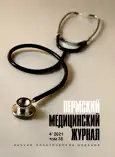Sanitary condition of soil in the territory of Astrakhan state technical university and nearby territories of higher educational institutions
- Authors: Irdeeva V.A.1,2, Arakelyan R.S.2, Ikenova A.A.3, Stepanenko E.A.3, Novokshchenova E.A.3, Alekseeva A.S.3, Maslyaninova A.E.2, Mirmanova I.M.2, Gadzhimuradova M.F.2, Artsueva K.B.2
-
Affiliations:
- Clinical Maternity Hospital
- Astrakhan State Medical University
- Astrakhan State Technical University
- Issue: Vol 38, No 4 (2021)
- Pages: 6-17
- Section: Original studies
- URL: https://bakhtiniada.ru/PMJ/article/view/64187
- DOI: https://doi.org/10.17816/pmj3846-17
- ID: 64187
Cite item
Full Text
Abstract
Objective. The authors of this article studied and analyzed the sanitary condition of the soil in the territory of Astrakhan State Technical University and the nearby territories of higher educational institutions.
Materials and methods. The study was carried out in May – June 2019 on the basis of the laboratory of the Department of Infectious Diseases and Epidemiology of Astrakhan State Medical University and the laboratory of the Department of Applied Biology and Microbiology of Astrakhan State Technical University. Thirty soil samples were taken from these territories.
The studies of soil samples for parasitological indicators were performed according to the guidelines "Control Methods. Biological and Microbiological Factors. Methods of Sanitary and Parasitological Research", for microbiological indicators – "Methods of Soil Microbiological Control".
Results. The following results were obtained: the sanitary-parasitological condition of the soil in parks near higher educational institutions in Astrakhan remains very tense as evidenced by positive findings of geohelminthoses; when assessing the degree of epidemic hazard of soil, there were identified nematode eggs and adult worm Strongyloids, that corresponds to the indicators of moderately hazard soil; the presence of live strongylid larvae in the studied samples indicates contamination of the soil with feces of infested animals, and the presence of Ascaris eggs indicates contamination of the soil with sewage or feces of infested children walking and resting in these territories; the total microbial number on average gave indicators for evaluating the selected soil samples as a slightly polluted soil.
Conclusions. The sanitary and parasitological state of soil in parks of Astrakhan higher educational institutions remains rather tense as evidenced by positive findings of geohelminthoses.
Keywords
Full Text
##article.viewOnOriginalSite##About the authors
V. A. Irdeeva
Clinical Maternity Hospital; Astrakhan State Medical University
Email: rudolf_astrakhan@rambler.ru
clinical resident, Department of Infectious Diseases and Epidemiology
Russian Federation, AstrakhanR. S. Arakelyan
Astrakhan State Medical University
Author for correspondence.
Email: rudolf_astrakhan@rambler.ru
Associate Professor, Candidate of Medical Sciences, Associate Professor of Department of Infectious Diseases and Epidemiology, parasitologist of the Highest Qualification Category
Russian Federation, AstrakhanA. A. Ikenova
Astrakhan State Technical University
Email: rudolf_astrakhan@rambler.ru
Lecturer, Department of Applied Biology and Microbiology
Russian Federation, AstrakhanE. A. Stepanenko
Astrakhan State Technical University
Email: rudolf_astrakhan@rambler.ru
master, Department of Hydrobiology and General Ecology
Russian Federation, AstrakhanE. A. Novokshchenova
Astrakhan State Technical University
Email: rudolf_astrakhan@rambler.ru
third-year student, Faculty of Veterinary and Sanitary Expert Examination
Russian Federation, AstrakhanA. S. Alekseeva
Astrakhan State Technical University
Email: rudolf_astrakhan@rambler.ru
third-year student, Faculty of Veterinary and Sanitary Expert Examination
Russian Federation, AstrakhanA. E. Maslyaninova
Astrakhan State Medical University
Email: rudolf_astrakhan@rambler.ru
sixth-year student, Pediatric Faculty
Russian Federation, AstrakhanI. M. Mirmanova
Astrakhan State Medical University
Email: rudolf_astrakhan@rambler.ru
Cтудентка 3 курса лечебного факультета
Russian Federation, AstrakhanM. F. Gadzhimuradova
Astrakhan State Medical University
Email: rudolf_astrakhan@rambler.ru
sixth-year student, Pediatric Faculty
Russian Federation, AstrakhanKh. B. Artsueva
Astrakhan State Medical University
Email: rudolf_astrakhan@rambler.ru
third-year student, Medical Faculty
Russian Federation, AstrakhanReferences
- Bedlinskaya N.R., Arakelyan R.S., Karpenko S.F., Ivanova E.S., Martynova O.V., Imamutdinova N.F., Donskova A.Yu., Kalashnikova T.D., Sokolova Ya.O., Kuzmichev B.Yu., Melnikova K.Yu. Sanitary-parasitological state of environmental objects of the Astrakhan region. Pest Management 2016; 3 (99): 5–8 (in Russian).
- Buzinov R.V., Parfenova E.P., Gudkov A.B., Unguryanu T.N., Gordienko T.A. Assessment of the epidemiological hazard of the soil in the Arkhangelsk region. Human Ecology 2012; 4: 3–10 (in Russian).
- Voloshina N.A., Stets G.V. The parasitic system of the city: problems and solutions. Actual biotechnology 2014; 3 (10): 12–16 (in Russian).
- Karpenko S.F., Galimzyanov H.M., Kasimova N.B., Kraskov A.V. Age-related aspects of clinical manifestations of coxyellosis depending on the treatment performed. Astrakhan medical journal 2013; 8 (4): 74–75 (in Russian).
- Kuznetsova T.N., Sysoeva N.Yu. Sanitary-parasitological control of soil. Science and technology in modern society 2015; 1 (2): 3–5 (in Russian).
- Methods of soil microbiological control: guidelines. Moscow, 2014 (in Russian).
- MUC 4.2.2661-10. Сontrol Methods. Biological and microbiological factors. Methods of sanitary-parasitological research. Moscow 2010 (in Russian).
- Mirekina E.V., Galimzyanov H.M., Bedlinskaya N.R. The role of an imbalance of the oxidant-antioxidant system in the development of hemocoagulation disorders in certain infectious diseases. Astrakhan medical journal 2017; 12 (2): 15–22 (in Russian).
- Merekina E.V., Galimzyanov Kh.M., Belinskaya N.R. Modern aspects of hemostasis state in the West Nile. Pest Management 2017; 3 (103): 11–16 (in Russian).
- Mirekina E.V., Lazareva E.N., Khok M.M., Bedlinskaya N.R., Arakelyan A.S., Babayeva M.A., Siradegyan S.E., Saidov R.T., Kobchenko N.V. Influence of oxidative stress on platelet functional activity in patients with Congo-Crimean hemorrhagic fever. International journal of applied and fundamental research 2013; 3: 149–150 (in Russian).
- SanPiN 2.1.7.1287-03. Sanitary and epidemiological requirements for soil quality. Approved by the Chief state sanitary doctor of the Russian Federation on 16.04.2003 (in Russian).
- Ten A.E., Sysoeva N.Yu., Panova O.A. Sanitary-parasitological study of the soil of the territory of the city of Moscow. Agricultural sciences and the agro-industrial complex at the turn of the century: collection of materials of the XIX International Scientific and Practical Conference. Edited by S.S. Chernov. Moscow 2017; 141–147 (in Russian).
Supplementary files








